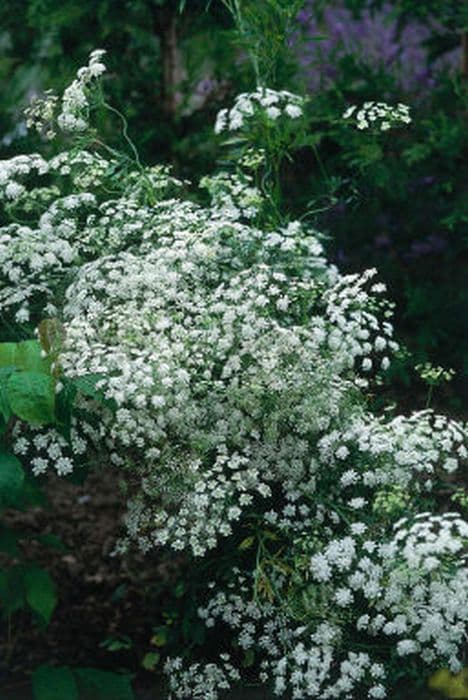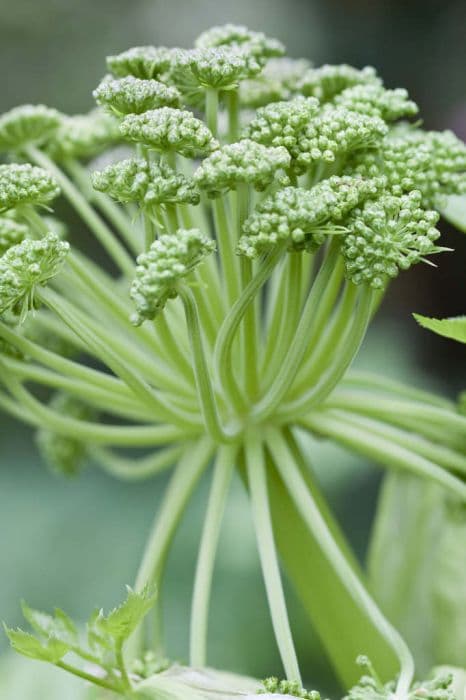Sea Holly Eryngium planum 'Blue Hobbit'

ABOUT
The 'Blue Hobbit' is a visually striking ornamental plant known for its distinctive blue coloration and unique spiky texture. The plant features a basal rosette of narrow, lance-shaped leaves that are typically a deep green with a slightly spiky edge. Rising above the foliage, the plant bears numerous branched stems, each topped with a cone-shaped flower head that is encased in a ruff of spiny bracts. These bracts are usually a steely blue or bluish-gray hue and provide an attractive contrast to the actual flowers, which are small and often nestled within the protective spiny collar. These blooms often attract bees and butterflies due to their vibrant color and accessibility. The overall aesthetic of 'Blue Hobbit' is one of rugged beauty, with its clustered flower heads resembling tiny, medieval maces or ornate pincushions. This hardy perennial has a tight, clumping form that makes it suitable for various garden roles, including borders, rockeries, or as a singular specimen in a garden. Its robust nature and intriguing appearance make it a favorite among gardeners looking to add a touch of whimsy and color to their outdoor spaces.
About this plant
 Names
NamesFamily
Apiaceae
Synonyms
Blue Hobbit Sea Holly, Dwarf Sea Holly, Dwarf Flat Sea Holly
Common names
Eryngium planum
 Toxicity
ToxicityTo humans
Blue Hobbit is not known to be toxic to humans. However, it is always advisable to exercise caution and avoid ingesting plants that are not commonly recognized as edible to prevent any potential adverse reactions.
To pets
Blue Hobbit is not known to be toxic to pets. As with humans, it is generally recommended to prevent pets from ingesting plants that are not specifically intended for consumption to avoid the possibility of stomach upset or other negative reactions.
 Characteristics
CharacteristicsLife cycle
Perennials
Foliage type
Deciduous
Color of leaves
Green
Flower color
Blue
Height
1 foot (30 cm)
Spread
8 inches (20 cm)
Plant type
Herb
Hardiness zones
5
Native area
Europe
Benefits
 General Benefits
General Benefits- Attracts pollinators: 'Blue Hobbit' is popular among bees, butterflies, and other beneficial insects, enhancing pollination in the garden.
- Drought resistant: Once established, this hardy perennial can withstand periods of low water, making it suitable for xeriscaping or drought-prone areas.
- Low maintenance: It requires minimal care, not needing regular fertilization or pruning, ideal for a low-effort garden.
- Deer and rabbit resistant: The plant is not favored by deer and rabbits, making it a good choice for gardens where these animals are a nuisance.
- Ornamental appeal: The striking blue flowers and spiny, silvery green foliage add unique texture and color to landscapes and flower arrangements.
- Long blooming period: Its long-lasting flowers bloom from midsummer to early fall, providing extended visual interest in the garden.
- Compact size: The 'Blue Hobbit' variety is smaller than other Eryngium species, which makes it suitable for borders, pots, or small gardens.
- Resilient to pests: It is generally free from major pest problems, ensuring that it remains healthy and attractive without extensive interventions.
- Tolerant of various soil types: This plant can thrive in a range of soil conditions, including poor or rocky soils, as long as they are well-draining.
 Medical Properties
Medical Properties- Diuretic effects: Eryngium planum has been traditionally used to increase urine output.
- Anti-inflammatory properties: It may reduce inflammation in certain conditions.
- Antitussive action: It has been used to calm coughs and as a remedy for colds.
- Antioxidant properties: The plant contains compounds that exhibit antioxidant activity.
- Antimicrobial activity: Some studies have indicated that it can have an inhibiting effect on certain bacteria and fungi.
 Air-purifying Qualities
Air-purifying QualitiesThis plant is not specifically known for air purifying qualities.
 Other Uses
Other Uses- Eryngium planum 'Blue Hobbit', commonly known as Sea Holly, can be used in dried floral arrangements as its unique structure and color are retained even after the plant has dried out.
- Sea Holly can be planted as a natural barrier due to its spiky leaves, deterring animals and humans from crossing into protected garden areas.
- The plant can serve as an educational tool in botany classes to demonstrate xeriscaping principles because of its drought-resistant qualities.
- Sea Holly is utilized in landscaping to create a contrast with its blue flowers against green foliage or other flowering plants in a garden design.
- The roots of Sea Holly can be used in the creation of specialty liquors or bitters for unique cocktail flavors, adhering to regulations and safe consumption guidelines.
- It's often included in ornamental garden borders to attract pollinators like bees and butterflies, thereby enhancing the pollination of nearby plants.
- Sea Holly can be used in winter gardens as its silhouette provides visual interest and structure during the colder months when other plants have died back.
- This plant can be featured in coastal-themed gardens due to its tolerance of saline soils and to evoke a seaside aesthetic.
- The spiky texture of Sea Holly can be used in tactile garden experiences designed for the visually impaired, as it offers a distinct feel compared to other plants.
- Craft enthusiasts use the distinct form of Sea Holly in creating natural jewelry, such as brooches or pendants, after properly preserving the flowers.
Interesting Facts
 Feng Shui
Feng ShuiSea Holly is not used in Feng Shui practice.
 Zodiac Sign Compitability
Zodiac Sign CompitabilitySea Holly is not used in astrology practice.
 Plant Symbolism
Plant Symbolism- Independence: The Eryngium planum 'Blue Hobbit', also known as Sea Holly, often symbolizes independence because of its ability to thrive in harsh conditions without much care, resembling self-sufficiency and personal strength.
- Attraction and allure: Sea Holly is known for its striking blue color and unique spiky appearance, evoking a sense of fascination and the power of attraction.
- Protection: Historically, Sea Holly was thought to offer protection against evil spirits and negativity, possibly because of its thorny and tough demeanor, which suggests a natural shield.
- Healing: In herbal medicine, Sea Holly has been used for its purported medicinal properties, therefore it is sometimes associated with healing and the restoration of health.
 Water
WaterSea Holly prefers to be watered deeply but infrequently as it is drought tolerant once established. Ideally, the soil should be allowed to dry out between waterings. Watering should be done close to the base of the plant to avoid wetting the foliage, which could lead to disease. During the active growing season in spring and summer, watering might be required every week if there is no significant rainfall, with each watering consisting of about 1 to 1.5 gallons per plant. In cooler weather or when the plant is dormant in winter, reduce watering to every few weeks or when the soil is dry several inches below the surface.
 Light
LightSea Holly thrives best in full sun conditions, where it can receive at least six to eight hours of direct sunlight per day. It can handle some light shade but will produce the strongest growth and best flower production in full sun. Choose a spot in the garden that is not shaded by taller plants or structures to ensure it gets the sunlight it needs.
 Temperature
TemperatureSea Holly is quite hardy and can tolerate temperatures down to about -20°F in winter. The ideal temperature range for growing Sea Holly is between 65°F and 75°F during the growing season, but it can withstand higher summer temperatures if adequately watered. The plant may struggle if temperatures consistently exceed 90°F without sufficient water and shade during the hottest part of the day.
 Pruning
PruningSea Holly benefits from pruning to remove spent flowers and encourage additional blooming. This task is typically done after the flowering period in the late summer or early fall. Cut back the flower stems down to the base of the plant. Additionally, some gardeners perform light pruning in early spring to shape the plant and remove any dead or damaged foliage from winter. Pruning this plant is usually done on an as-needed basis rather than on a strict schedule.
 Cleaning
CleaningAs needed
 Soil
SoilSea Holly 'Blue Hobbit' thrives in well-draining soil with a mix of loam, peat, and sand. The ideal soil pH is slightly alkaline, around 7.0 to 7.5. To create the best soil mix, combine two parts loam with one part peat and one part coarse sand or gritty material to ensure good drainage and aeration.
 Repotting
RepottingSea Holly 'Blue Hobbit' does not require frequent repotting; it should be repotted only when it outgrows its current container. This is typically every 2-3 years. During repotting, choose a slightly larger pot to provide space for growth.
 Humidity & Misting
Humidity & MistingSea Holly 'Blue Hobbit' is tolerant of a wide range of humidity levels and does not require high humidity to thrive. Average room humidity should suffice, making it adaptable to most indoor environments without the need for special humidity adjustments.
 Suitable locations
Suitable locationsIndoor
Use well-draining soil, provide full sun, and maintain low humidity.
Outdoor
Plant in full sun, well-drained soil, and space 12" apart.
Hardiness zone
4-9 USDA
 Life cycle
Life cycleEryngium planum 'Blue Hobbit', also known as Sea Holly 'Blue Hobbit', starts its life cycle from seed germination that commonly occurs in spring when the soil warms up. Following germination, the seedling develops a rosette of basal leaves during its first growing season. In the second season, 'Blue Hobbit' produces tall, branching stems adorned with distinctive blue-green leaves and spiny, cone-shaped blue or purplish flowers in mid to late summer, which are highly attractive to pollinators. After flowering, seeds set and are dispersed from the dried flower heads in late summer or fall. During winter, plants die back to the ground, with the root system surviving to regrow the next spring. Sea Holly 'Blue Hobbit' is a perennial, repeating this cycle for several years before it may require division or replacement due to natural aging or crowded conditions.
 Propogation
PropogationPropogation time
Late Spring-Early Summer
Eryngium planum 'Blue Hobbit', commonly known as Sea Holly 'Blue Hobbit', is most successfully propagated through seed sowing. The ideal time for sowing Sea Holly 'Blue Hobbit' seeds is in late winter to early spring, when the temperature is not too harsh for the seeds to develop. Seeds should be sown superficially, lightly covered with soil, and kept moist until germination, which usually takes about two to three weeks. To improve germination rates, a period of cold stratification may be beneficial; this involves chilling the seeds for a couple of weeks in a refrigerator before sowing. Once the seedlings have grown sufficiently large, usually with a couple of sets of true leaves, they can be transplanted into individual pots or into their final position in the garden.









